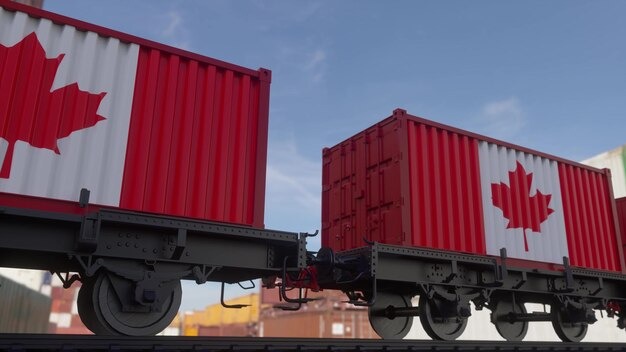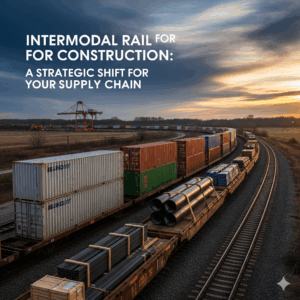Shipping goods across Canada has always presented unique challenges due to the country’s vast geography, diverse terrain, and varying infrastructure. Whether you’re a small business owner, a large manufacturer, or an individual sender, finding the cheapest way to ship across Canada without compromising on reliability and speed is a top priority. As we move deeper into 2025, the landscape of Canadian shipping is evolving rapidly with new technologies, regulatory changes, and innovative logistics solutions transforming how freight moves from coast to coast.
If you’re wondering how to save money while ensuring your shipments arrive safely and on time, you’re in the right place. This ultimate guide reveals actionable hacks and industry insights that will help you unlock the cheapest way to ship across Canada in 2025. From choosing the right transportation mode to optimizing your shipping practices, you’ll learn how to stretch your logistics budget further without sacrificing quality or service.
Understanding the Complexity of Shipping in Canada
Canada is the second-largest country in the world by land area, spanning over 9.9 million square kilometers. This sheer size, combined with varying population densities—highly concentrated in urban centers but sparse in remote northern regions—means shipping across Canada is a complex puzzle. The challenge is to balance cost, speed, and reliability across a network of roads, railways, ports, and airports.
In 2025, shippers seeking the cheapest way to ship across Canada must consider multiple factors:
- Geographic distance: Longer routes naturally increase shipping costs, especially for less-than-truckload (LTL) and parcel shipments.
- Mode of transport: Rail, truck, air, and marine options all carry different pricing structures and transit times.
- Freight type and volume: Bulk shipments often have more cost-effective options than small, irregular parcels.
- Seasonal weather impacts: Canada’s harsh winters and summer storms can disrupt shipments and add unforeseen expenses.
- Customs and regulations: Cross-border shipments add layers of compliance and fees that affect overall costs.
Grasping these elements helps businesses unlock the cheapest way to ship across Canada by tailoring solutions specific to their freight needs.
Why Intermodal Shipping is the Cheapest Way to Ship Across Canada
One of the most significant trends reshaping Canadian freight in 2025 is the rise of intermodal shipping—the use of multiple transportation modes like rail and truck in one seamless journey. Intermodal transport combines the speed and flexibility of trucking with the cost-efficiency and environmental benefits of rail.
Rail is widely recognized as the cheapest way to ship across Canada for large, heavy shipments traveling long distances. Compared to trucking alone, rail transport reduces fuel consumption and driver labor costs, passing savings directly to shippers. When paired with local trucking for last-mile delivery, intermodal shipping offers the best of both worlds.
Key advantages making intermodal shipping the cheapest way to ship across Canada include:
- Lower per-mile cost: Railways can move large volumes of freight at significantly reduced rates over thousands of kilometers.
- Reduced fuel consumption: Rail is up to four times more fuel-efficient than trucks, cutting fuel surcharges and carbon footprint.
- Less congestion: Rail networks avoid highway traffic delays, reducing the risk of costly shipment delays.
- Flexibility: Combining rail and truck allows customized routes tailored to specific delivery needs.
As you strategize the cheapest way to ship across Canada, embracing intermodal solutions can lead to substantial cost savings, especially for businesses shipping bulk goods or freight on regular schedules.
Optimizing Packaging and Freight Consolidation to Cut Costs
Finding the cheapest way to ship across Canada isn’t only about choosing the right transportation mode—it also means optimizing how you pack and consolidate your shipments.
Efficient packaging reduces dimensional weight charges, lowers damage risk, and maximizes container or trailer space. In 2025, shippers are increasingly adopting sustainable packaging materials that are lighter and stronger, which also contribute to cost savings by lowering overall freight weight.
Freight consolidation—combining multiple smaller shipments into one larger shipment—is another proven hack for the cheapest way to ship across Canada. Consolidation helps you qualify for bulk rates, reduces per-unit shipping costs, and simplifies logistics management. Many Canadian logistics providers now offer consolidation services that merge freight from multiple clients going to similar destinations, unlocking new levels of savings.
Leveraging Technology for Smarter Shipping Decisions
Technology is a game-changer when it comes to finding the cheapest way to ship across Canada. In 2025, digital freight marketplaces, AI-powered rate comparison tools, and real-time tracking apps empower shippers to make smarter, more cost-effective decisions.
For example, freight management systems (FMS) can analyze multiple shipping options based on cost, speed, and reliability, allowing you to select the best route and carrier. These platforms often include features for automated booking, invoicing, and performance analytics that streamline operations and reduce administrative expenses.
Investing in technology doesn’t just save money—it also increases transparency and control, which reduces costly errors and enhances customer satisfaction.
How Regulatory Changes Impact Shipping Costs in 2025
Shipping costs in Canada are influenced by a complex web of regulations, including environmental policies, safety standards, and cross-border trade agreements. Staying compliant avoids expensive fines and delays, both of which add to your shipping expenses.
In 2025, new federal and provincial regulations targeting carbon emissions are pushing freight companies to adopt greener practices. While this can increase some costs upfront, in the long run, it incentivizes more efficient shipping methods—such as rail and intermodal transport—that help shippers discover the cheapest way to ship across Canada while meeting sustainability goals.
Furthermore, updates in customs procedures and trade facilitation agreements between Canada and the US are streamlining cross-border freight movement, reducing wait times and costs associated with delays.
Practical Tips to Unlock the Cheapest Way to Ship Across Canada
To capture the best rates and optimize your shipping strategy in 2025, consider the following practical tips:
- Negotiate with multiple carriers: Don’t settle for the first quote. Competitive bidding drives down costs.
- Plan shipments in advance: Last-minute shipments can attract premium charges. Early planning unlocks better rates.
- Use freight brokers and 3PLs: Third-party logistics providers have buying power and industry connections that translate into savings.
- Consider off-peak shipping: Avoid rush periods where demand spikes prices.
- Bundle shipments whenever possible: Combine orders to qualify for volume discounts and reduce handling fees.

What Causes the Cost to Be High?
High shipping costs in Canada? By understanding the obstacles, we’ll plan victory! Ready to reshape your shipping purpose’s and turn it into a profit? Let’s explore the cheapest way to ship across Canada!
Geographical Size and Distance
Finding the cheapest way to ship across Canada can be tough because it’s a big country with places far apart. Which have a direct influence on shipping costs.
Longer travel times require more fuel usage for vehicles, ships, and planes. Which raises the operating costs. Additionally, route planning becomes more complicated as the distance increases. Which raises expenses even further. Building additional infrastructure (rest stops, storage) further increases expenses.
Navigation and regulations drive up Canada’s shipping burden. This double issue increases the impact of size and location, making it costly to ship goods.
Low Population Density
With the country being so large and the population widely spread out, finding the cheapest way to ship across Canada can be challenging. Reaching certain remote areas gets complicated. Resulting in a reduced overall customer base.
Low density areas mean fewer shipments, making transportation and logistics costly. Size, regulations, and extra fees further multiply shipping costs.
Shipping companies need to charge more because it costs more to deliver to fewer people in spread-out areas. Canada’s low population density makes shipping expensive because it’s harder to spread the costs around.
Infrastructure Challenges
Delivering to remote parts of Canada with limited roads is like taking a plane instead of a car – it’s more expensive! Plus, bumpy roads in some areas make trips longer and wear down vehicles faster, driving up costs even more.
Furthermore, there are fewer roads and infrastructure in the northern areas. Finding the cheapest way to ship across Canada can be more complicated than usual. So companies have less competition and can charge more. Harsh winters cause delays and require special equipment, adding to the already increasing cost.
Weather and Climate
Heavy snow, ice, and freezing temperatures in Canada can disrupt shipping. And to solve that, special equipment like snow tires and plows is crucial for winter deliveries.
Snowy winters in Canada mean drivers have to take longer routes to avoid bad roads. This snowy climate makes deliveries slower and more expensive, therefore finding the cheapest way to ship across Canada, is even more challenging. Even without snow, the extreme cold can damage trucks. Which leads to more repairs and even more delays.
This adds extra costs and disrupts delivery chains since workers need to take detours across the hard lands.

Coastal areas face a whole different category of challenges. Such as rough seas and storms can delay ships and damage packages. Which, in turn, raises insurance costs.
Limited Competition
In Canada, only a few shipping companies are available. This means less competition and more of a challenge to find the cheapest way to ship across Canada. As a result, large corporations can increase their prices without losing clients. This hits small towns especially hard.
There are currently fewer alternatives available. The corporations are under no pressure to enhance their prices or services. Customers have less bargaining power, so these constraints remain constant.
Fuel Costs
As rising oil prices raise the cost of everything, fuel accounts for a significant part of shipping expenses. Think gas stations, but for mega-vehicles! So, an increase in the global oil market equals expensive deliveries across the board.
Canada’s massive size makes matters worse, as driving across more states requires more gas. Furthermore, isolated places need specialized transportation, which consumes even more gasoline, raising the expense.
The “Cheapest Way To Ship Across Canada” Dilemma
So, you’ve got questions? Don’t worry; we’ve got answers. What are the secrets to the cheapest way to ship across Canada? Let’s get into it.
Cheapest way to ship across Canada? Go land! While slower than fancy options, ground shipping saves major costs, which is ideal if timing isn’t tight.
Now let’s dive into the technical details.
- Cheapest Small Parcel Shipping Method Across Canada
Sending tiny parcels across Canada? Ground delivery via LTL (Less-Than-Truckload) carriers is your wallet’s greatest friend! It’s inexpensive, dependable, and ideal for anything that doesn’t need to arrive overnight.
- Cheapest Large Parcel Shipping Method Across Canada:
Big packages, big problems? Not anymore! When your parcels get big or heavy, regular shipping just won’t cut it. That’s where freight shipping comes in! Companies like Canadian Pacific Railway and Canadian National Railway offer this service. Providing a helping hand for delivering your giant items safely and affordably.
Decided to go the freight route? Before you jump in, let’s talk about the two main options available.
- Less-Than-Truckload or LTL Shipping
LTL shipping is a cost-effective and adaptable alternative for transporting small items. This service effectively combines many insufficient cargoes onto a single truck. Maximizing both space use and operational expenses.
Instead of renting a whole truck for your stuff, LTL shipping lets you share space with others. This makes it cheaper and more competitive! It works like carpooling for packages, saving money and space.
This option is especially helpful for small businesses looking to cut costs while sending items of various sizes.
- Full-Truckload or FTL Shipping
Need to move a lot of stuff? FTL shipping is your friend! It’s like renting an entire truck for your cargo, ideal for small enterprises with large shipments. You pay for the entire vehicle, making it highly affordable for large volumes. Furthermore, your belongings are transported directly from point A to point B, ensuring both safety and speed.
How To Find The Cheapest Way to Ship Across Canada?
For online retailers, striking the right balance in shipping costs is very important. As, setting rates too low can lower your profits, while charging too much can push away potential customers.
While major carriers often offer free shipping, they have strategically planned this to maximize their revenue.
The Power of Calculated Shipping
One effective approach is to calculate shipping costs for each product and location. This might seem time-consuming, but it offers several benefits:
- Instant Quotes: Customers appreciate transparency, and instant shipping quotes build trust and loyalty.
- Enhanced Brand Loyalty: Clear and fair shipping costs contribute to a positive brand image.
- Reduced Cart Abandonment: Offering various shipping options at different price points empowers customers to choose the best fit, reducing the likelihood of abandoned carts.
Key Factors Influencing Shipping Costs
To accurately calculate shipping costs, consider these four primary factors:
Shipping Start and Destination:
- Shipping Zones: Carriers divide their service areas into zones, with rates increasing as the distance between origin and destination grows.
Package Weight, Size, and Dimension:
- Dimensional Weight: Carriers often use dimensional weight (DIM weight) to calculate shipping costs, especially for larger, lighter packages. DIM weight is calculated based on the package’s dimensions and can significantly impact shipping rates.
Shipping Service:
- Canada Post: As a leading carrier in Canada, Canada Post offers a range of services:
- Regular Parcel: Affordable ground shipping with tracking and delivery confirmation.
- Xpresspost: Faster delivery with tracking and on-time delivery guarantees.
- Priority: The fastest domestic service with next-day delivery to many locations.
- Flat Rate: Fixed-rate shipping for packages up to 5 kg with tracking.
Optimizing Your Shipping Strategy
To further optimize your shipping costs, consider using a shipping service like Stallion. Stallion offers discounted Canada Post rates, helping you save on shipping expenses.
By carefully considering these factors and implementing effective strategies, you can set competitive shipping rates that balance profitability and customer satisfaction.
Conclusion
Finding the cheapest way to ship across Canada in 2025 is more achievable than ever, thanks to evolving logistics solutions, innovative transportation methods, and the strategic use of technology. However, navigating Canada’s unique shipping challenges—vast geography, diverse climates, and complex regulations—requires more than just choosing the lowest rate. It demands a holistic, informed approach that balances cost-efficiency with reliability and service quality.
Why Cost-Efficiency Is Key in Canadian Shipping
Shipping in Canada inherently comes with higher costs compared to more compact countries due to distances, infrastructure, and seasonal weather impacts. Therefore, identifying the cheapest way to ship across Canada isn’t simply about cutting corners; it’s about optimizing every element of your supply chain. This optimization saves money while ensuring your freight reaches its destination safely and on time, supporting strong customer satisfaction and business growth.
The good news for shippers in 2025 is that there are multiple proven strategies to lower shipping expenses without sacrificing quality. Intermodal shipping, freight consolidation, smart packaging, and technology-driven logistics planning all contribute to uncovering the cheapest way to ship across Canada. Embracing these tactics helps companies stay competitive in a fast-paced market.
Intermodal Shipping: The Cornerstone of Cost Savings
One of the most powerful solutions to finding the cheapest way to ship across Canada is intermodal shipping. Combining rail and truck transport leverages the strengths of both modes—rail for cost-effective long-haul freight movement and trucks for flexible last-mile delivery.
Rail shipping is especially cost-efficient for bulk freight traveling long distances between major Canadian cities and ports. By shifting the heavy lifting to rail, shippers benefit from significantly reduced fuel costs and labor expenses. Then, trucks handle final delivery to remote or urban locations where rail can’t reach.
Moreover, the environmental advantages of intermodal shipping align with emerging regulations and corporate sustainability goals. Rail’s fuel efficiency reduces carbon emissions, making intermodal a forward-thinking choice for companies seeking to minimize both costs and their ecological footprint.
Maximizing Savings Through Smart Packaging and Freight Consolidation
Another critical factor in securing the cheapest way to ship across Canada is optimizing how you prepare your freight. Proper packaging reduces dimensional weight charges, protects cargo integrity, and allows for more efficient use of container space.
Freight consolidation is equally important. By combining multiple smaller shipments into a single load, you reduce the cost per unit shipped. Consolidated shipments attract bulk shipping discounts and simplify logistics management. Partnering with experienced logistics providers can help identify consolidation opportunities and optimize load planning.
Leveraging Technology for Smarter, Cost-Effective Shipping
In 2025, digital tools and technology are indispensable for uncovering the cheapest way to ship across Canada. Freight management platforms enable shippers to compare rates across carriers and modes instantly, optimizing routes based on cost, transit time, and service reliability.
Real-time tracking and data analytics provide visibility throughout the shipping process, reducing the risk of delays and unexpected charges. AI-powered forecasting tools can predict peak demand periods and suggest optimal shipment scheduling to avoid costly surcharges.
Incorporating technology into your logistics strategy reduces administrative overhead and empowers smarter decision-making, driving down overall shipping expenses.
Navigating Regulations and Avoiding Hidden Costs
Canadian shipping is subject to multiple layers of regulations affecting everything from driver hours to cargo weight limits and customs clearance. Staying compliant is crucial to avoid fines, delays, and added fees—factors that undermine efforts to find the cheapest way to ship across Canada.
Recent regulatory changes targeting environmental impacts encourage shifts toward more sustainable shipping methods such as intermodal transport. By proactively adapting to these regulations, shippers can avoid costly penalties and benefit from incentives or subsidies that reduce net shipping expenses.
Additionally, understanding cross-border customs procedures and ensuring accurate documentation helps minimize delays at Canada-US borders, a vital consideration for many Canadian businesses.
Practical Tips to Lock in the Cheapest Way to Ship Across Canada
To secure the cheapest way to ship across Canada in 2025, consider the following practical steps:
- Plan shipments well in advance: Early bookings often come with discounted rates and avoid expensive last-minute charges.
- Negotiate rates with multiple carriers: Competitive quotes give you leverage for better pricing and service terms.
- Use third-party logistics providers (3PLs): 3PLs have extensive networks and bargaining power, often passing savings to you.
- Avoid peak seasons and rush deliveries: Shipping during off-peak times reduces costs and improves capacity availability.
- Continuously audit your freight bills: Identifying billing errors and correcting them recovers money you might otherwise lose.
The Role of Expert Partners in Finding the Cheapest Way to Ship Across Canada
While the tips and technologies mentioned empower shippers to optimize costs independently, partnering with logistics experts remains one of the smartest investments for cost savings. Experienced logistics providers like RGW offer deep knowledge of Canadian shipping routes, regulations, and carrier networks.
RGW’s team can customize intermodal solutions that blend rail and road transport to suit your specific freight profile and budget. Their expertise in freight consolidation, load optimization, and regulatory compliance helps clients unlock significant cost reductions.
Moreover, RGW’s use of cutting-edge freight management technology ensures you receive competitive pricing and full shipment visibility, maximizing value while minimizing risks.
Final Thoughts: Embrace Innovation and Strategy for the Cheapest Shipping
As Canada’s freight environment continues to evolve in 2025, businesses that proactively adopt innovative logistics strategies will consistently find the cheapest way to ship across Canada. This involves embracing intermodal shipping, optimizing freight preparation, leveraging technology, and partnering with trusted experts.
Cost-efficient shipping isn’t about choosing the cheapest carrier or route blindly; it’s about smartly managing the entire supply chain to reduce expenses without compromising service. By doing so, your business will not only save money but also enhance reliability and sustainability—essential factors in today’s competitive market.
Contact RGW for Expert Assistance in Finding the Cheapest Way to Ship Across Canada
If you’re ready to unlock the cheapest way to ship across Canada in 2025, RGW is here to help. Our intermodal experts provide personalized consultations, free quotes, and tailored solutions designed to fit your freight needs and budget.
Visit railgateway.ca today to speak with one of our logistics specialists. Let RGW guide you through the complexities of Canadian shipping and deliver smarter, more affordable freight solutions that give your business a competitive edge.

FAQ’s
Is Shipping To Canada Difficult?
Shipping in Canada can be a real headache, but a customs broker can take the stress out! They’re like experts who know all the rules and regulations for getting your stuff into (or out of) Canada. They handle everything, so you can relax and know your package is in good hands.
Can I Ship Food To Canada?
Thinking about delivering food as a present to Canada? But sending food across borders can be difficult, and Canada has certain restrictions you must follow. The Canadian Food Inspection Agency (CFIA) regulates all food imports and requires additional paperwork for your food parcel.
Some additional requirements are –
- Foods must not be in a personal container but in the original manufacturer’s packaging.
- The packaging must be sealed and not hampered with.
- All ingredients must be on the container’s label.
- A shelf life of longer than 6 months but be applicable for all the selected foods.
What Is Shipper Fee?
When you buy something online, the shipping fee is how much it costs to get it delivered to you. Sellers are the ones who usually set the price. But sometimes you can give them an offer about it before you pay.
How We Can Help
For businesses looking to optimize their freight shipping with reliable, efficient, and cost-effective solutions, RailGateway.ca is your trusted partner in intermodal logistics. Whether you’re new to freight trains or want to enhance your existing supply chain, our team of intermodal experts is ready to guide you every step of the way.
Contact RailGateway.ca today for a free quote or to speak directly with one of our experienced intermodal specialists. Let us help you unlock smarter, smoother shipping solutions tailored to your unique needs.
Visit RailGateway.ca or call us to get started on transforming your freight shipping strategy in 2025 and beyond.





